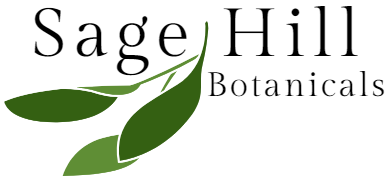Common yarrow (Achillea millefolium) is native to the dry, disturbed soils of prairies, meadows, and the edges of forest in the northern hemisphere. This perennial grows best in hardiness zones 3-9. It grows 36-inches high and produces white flowers. It is a bitter-tasting perennial of the Asteraceae family and is helpful in so many ways.
- Diaphoretic (opens pores and helps us sweat)
- Diuretic (increases urine flow) properties support our bodies during flus and fevers, as well as detoxifying chemicals in general
- Styptic (stops bleeding)

Botanical Name – Achillea millefolium
Family – Asteraceae
Parts Used – Flowers, Leaves, Roots
Energetics – Harmonizing
Plant Properties – Astringent, Relaxing Diaphoretic, Antiseptic, Diuretic, Anodyne
Plant Uses – Fever, Bleeding, Wounds, Infections, UTIs, Fibroids, Varicose Veins
Plant Preparation – Tea, Tincture, Smudge, Poultice
How To Make Yarrow Herbal Tea Or Infusion
An infusion is a tea made with the lighter, more delicate parts of herbs like the leaves and flowers, which release phyto-nutrients readily and quickly.
To create a wonderful cup of medicinal tea, place a heaping teaspoon of dried yarrow herb in a traditional teacup, or about 1 tablespoon of herb in a large teacup. A ‘traditional’ teacup holds about 1 cup; a ‘large’ teacup that holds about 2 cups.
Simply pour hot water (not boiling, as it can damage the phyto-nutrients) over the herbs in the cup. Stir the herbs so all herb pieces are submerged. Place a saucer over the cup to keep the steam, which holds much of the herbal essence, from escaping.
Let seep about 5 to 10 minutes, and then enjoy. If you like very hot tea, add a dash of hot water. If you don’t like the herb pieces floating in your cup, you can strain it into a fresh cup or use an infuser.
You can also make herbal tea from fresh herbs too. These teas usually have a sparkling lively essence, whereas the dry herbal teas, even made from the same herbs, have a more woodsy, nurturing, comforting flavor.
To make tea from fresh herbs, you’ll need more herb matter – try starting with 3 to 4 sprigs, ripped up or minced, and crushed in your hands (should come out to about 1-1/2 tablespoons for a ‘traditional’ teacup or 3 tablespoons for a ‘large.’) Place the herbs in the cup, pour water over, and seep. Fresh herbs take a bit longer to brew than dried herbs.
The amount of herb you use and the amount of seep time you allow are really a matter of personal preference. Your tea will develop stronger flavor and stronger medicinal value the more herb you use and the longer you seep. If you find your tea is too strong, you can easily dilute by adding more warm water.
How To Make Yarrow Herbal Decoction
A decoction, using the tougher pieces of herb such as stems, roots, and seeds, calls for a longer period of brewing and a bit of simmering. To make a decoction, place about ½ cup of herb material in a saucepan, pour about 4 cups of cool water over, and cover. Let soak for at least an hour or overnight. Then, bring the water to a very gentle rolling boil, and let simmer gently for about 15 minutes. Depending on your time and type of herb you’re using, you can skip the soaking stage and simply simmer the herbs for 30 minutes to an hour or so. Strain out herbs and enjoy.



